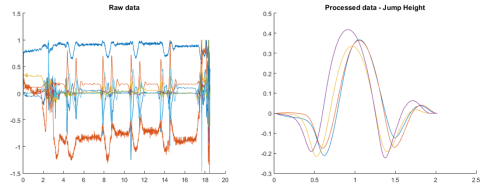By Andrew Bollen.
Here at IMeasureU, we’re all about data. But were faced with questions surrounding, How To Measure Interial Sport Sensor Data? How can we process it? And most importantly, how can we interpret it to give meaningful insights to an athlete or coach? The raw data collected from an Inertial Measurement Unit (IMU) on its own is pretty confusing to look at, and really not that useful at first glance. This is where we come in with the magic….

An IMU sensor takes samples of three different physical measurements, in each of the 3 directions of the sensor. The first is the straight line acceleration, or rate of change in speed in that particular direction. The second is the rate of rotation around that axis. The final measurements are the magnetic field strength in that same direction. This gives us a total of nine measurements for every point in time that we measure. Our sensors are able to measure all of these nine metrics at 500 times per second!
To gain helpful insights into the motion of the sensor in the real world, the orientation of the sensor should first be determined, else the measured accelerations are not meaningful. We pass all nine metrics into what we call a ‘fusion algorithm’, which does some complex math to determine this orientation relative to the direction of gravity and magnetic north.
Now that we know the orientation, we can use it to transform the accelerations measured in the constantly changing directions of the sensor, into global or fixed directions. This can then be used to glean more information about the movement of the sensor through space, and ultimately to deliver useful information back to the athlete or coach…. Your jump height is 7cm lower than this time last week. You are favoring heelstrike too much when you run. Your left leg is stronger than your right. You may be experiencing fatigue, and should rest up a while. Useful feedback??? I think so.




